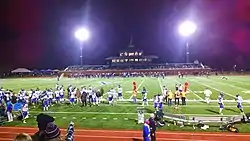| Sport | Football |
|---|---|
| First meeting | 1884 Williams, 15–2 |
| Latest meeting | November 11, 2023 Amherst, 21–14 |
| Next meeting | November 9, 2024 |
| Statistics | |
| Meetings total | 137 |
| All-time series | Williams leads, 75–57–5[1] |
| Largest victory | Amherst, 60–0 (1892) |
| Longest win streak | Williams, 8 (1987–1994) |
| Longest unbeaten streak | Williams, 13 (1987–1999) |
| Current win streak | Amherst, 1 (2023–present) |
 Amherst Williams Locations in Massachusetts | |
The Biggest Little Game in America is an American college football rivalry featuring the Amherst Mammoths and the Williams Ephs. Both programs play in the Division III New England Small College Athletic Conference. With the exception of a few hiatuses, the series has been played annually since 1884, making it the most played Division III rivalry game, and the fourth most played NCAA game at any level. Williams leads the all-time series 75–57–5.[2]
History

The storied rivalry between Amherst College and Williams College predates the advent of American football, having its roots in the early 19th century with the establishment of Amherst College in 1821. Notably, the rivalry was catalyzed by the actions of Zephaniah Swift Moore, who served as the president of Williams College at the time. Moore's persistent belief that Williamstown, the location of Williams College, was too remote led to the inception of this enduring competition. Failing to orchestrate the relocation of Williams College, President Moore opted to embark on the formation of a new educational institution in Amherst, MA. In doing so, a faction of professors and students from Williams College joined him in this endeavor, subsequently leading to the establishment of Amherst College. This decisive turn of events sowed the seeds of a long-standing and fervent rivalry between the two institutions, which has persisted to this day.
This rivalry extends beyond football, and tensions between Amherst College and Williams College have consistently remained high over the years. To further emphasize the significance of this competition, both institutions, in conjunction with Wesleyan University, partake in the "Little Three" series. This series serves as a deliberate nod to the more renowned "Big Three" grouping that traditionally comprises Harvard, Yale, and Princeton.
Notably, the November 10, 2007 contest between Amherst College and Williams College, hosted in Williamstown, achieved noteworthy recognition as the selected location for ESPN's College GameDay. This particular event holds historical significance as the first instance in which the program visited and highlighted a Division III school. Moreover, in 2003, the Amherst-Williams rivalry earned its place of distinction when it was included in ESPN's Page 2 bracket, celebrating the best college football rivalries.
On November 11, 2017, another memorable chapter was added to the rivalry's annals, as Williams College triumphed over Amherst in a game held in Williamstown. The victory was secured in a thrilling overtime contest, culminating in a score of 31–24. This overtime outcome marked only the second occurrence of overtime play in the storied history of this enduring and fiercely contested rivalry.
The first intercollegiate baseball game was played between Amherst and Williams in 1859. In that game, which lasted nearly four hours, Amherst defeated Williams by the score of 73–32.[3]
Game results
| Amherst victories | Williams victories | Tie games |
| |||||||||||||||||||||||||||||||||||||||||||||||||||||||||||||||||||||||||||||||||||||||||||||||||||||||||||||||||||||||||||||||||||||||||||||||||||||||||||||||||||||||||||||||||||||||||||||||||||||||||||||||||||||||||||||||||||||||||||||||||||||||||||||||||||||||||||||||||||||||||||||||||||||||||||||||||||||||||||||||||||||||||||||||||||||||||||||||||||||||||||||||||||||||||||||||||||||||||||||||||||||||||||||||||||||||||||||||||||||||||||||||||||||||||||||||||||||||||||||||||||||||||||||||||||||||||||||||||||||||||||||||||||||||||||||||||||||||||||||||||||||||||||||||||||||||||||||||||||||||||||||||||||||||||||||||||||||||||||||||||||||||||||||||||||||||||||||||||||||||||||||||||||||||||||||||||||||||||
See also
References
- ↑ "NESCAC Champs! Amherst Finishes 8-0, Defeats Williams, 17-7". 14 November 2015. Retrieved 25 March 2018.
- ↑ "127th Meeting in 'The Biggest Little Game in America' Williams at Amherst 11/10". D3football.com. 2012-11-09. Retrieved 2013-10-05.
- ↑ Timanus, Eddie (2009-04-30). "Amherst, Williams continue baseball series of 150 years". USAToday. Retrieved 2013-10-05.
- ↑ "AMHERST BEATS RIVAL; Williams College Loses Battle Through Madden's Field Goal". The New York Times. 22 November 1908. Retrieved 25 March 2018.
- ↑ "Amherst vs Williams (MA)". College Football Data Warehouse. Archived from the original on February 25, 2016. Retrieved 2016-05-15.


